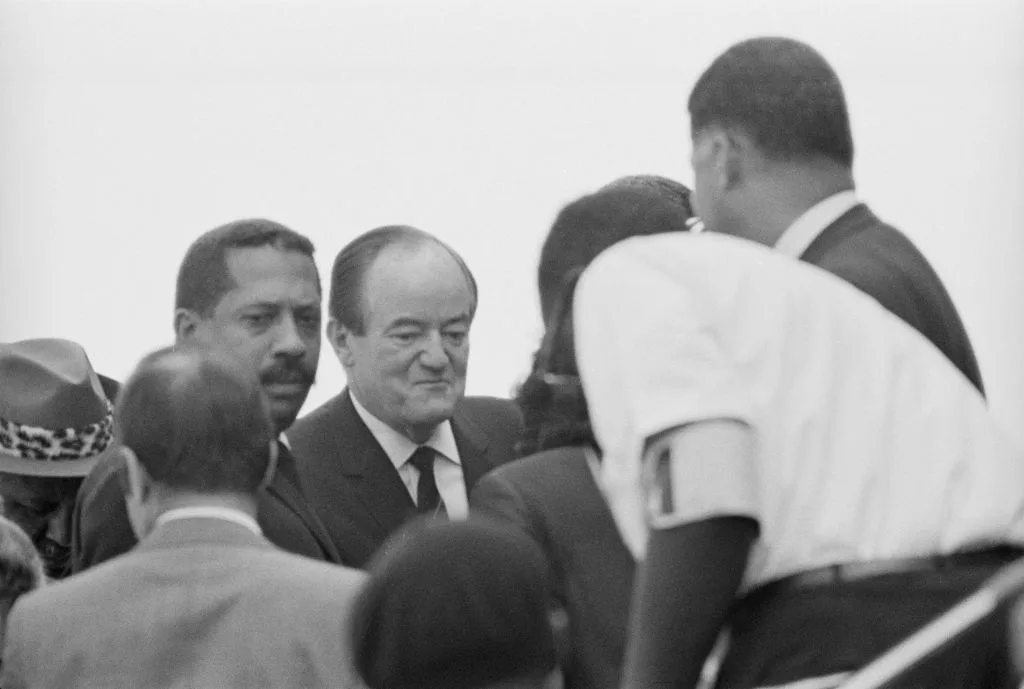
Seventy-five years ago this month, Hubert Humphrey proclaimed from the podium of the Democratic National Convention in Philadelphia that “[t]he time has arrived in America for the Democratic Party to get out of the shadows of states’ rights and to walk forthrightly into the bright sunshine of human rights.”
In so doing, Humphrey both facilitated the Democratic Party’s movement to the right side of history and laid the groundwork for the eventual schism with the Southern “Dixiecrats” who had loyally supported the party since the election of President Abraham Lincoln, our nation’s first Republican president — but within a couple of generations would leave the party in protest and remake both the modern Democratic and Republican parties.
Without minimizing the importance of Humphrey’s speech, it is worth noting that the Democratic Party’s embrace of civil rights in its 1948 platform only brought the party of Presidents Franklin Roosevelt and Harry Truman to a position that the Republican party, as well as the Progressive Party, had already adopted.
Moreover, the politics of the summer of 1948 came in the wake of the landmark Shelley v. Kraemer decision in which the Supreme Court invalidated the use of the courts to enforce restrictive housing covenants.
Beyond nostalgia or Minnesota pride, why is it worth remembering Humphrey’s speech, as well as the first of many post-war Civil Rights victories at the Supreme Court?
More pointedly, how can these two seminal moments from 75 years ago inform how we think about our nation today?
At a time when there is much consternation regarding the recent direction of the U.S. Supreme Court, it is critical to understand that lasting progress and societal change cannot be achieved simply through the decisions of an appointed court, and instead must be won through the political process and by the changing of hearts and minds.
Returning to Humphrey in July 1948 — then the mayor of Minneapolis and the DFL candidate for U.S. Senate — consider the world that he lived in with the knowledge that he had and without the benefit of hindsight and well-researched history that all future generations possess. (Samuel Freedman’s eloquent and authoritative “Into the Bright Sunshine: Young Hubert Humphrey and the Fight for Civil Rights,” which was released earlier this month, is perhaps the best example of such well researched history).
Humphrey was also stepping double-time into the politics of the 1948 presidential election. Truman’s campaign for another term was in serious jeopardy. Former Vice President Henry Wallace was running for president as an insurgent, independent candidate threatening to take liberal votes away from the incumbent. The Southern segregationist “Dixiecrats” in the Democratic Party were looking for a reason to bolt.
Truman had little patience for any of the factions and believed Humphrey naive and a threat to political stability if the Minnesotan mishandled the civil rights plank in the upcoming platform debate.
Humphrey was of course also very aware that with the Shelley v. Kraemer decision the Supreme Court was open to invalidating at least the most blatant forms of legal segregation.
Still, while for us living in 2023 the progression from Shelley to Brown vs. Board of Education and then to the Civil Rights Act of 1964 and Voting Right Act of 1965 may seem inevitable, in 1948 there were hardly any guarantees that these seminal moments would be realized. After all, it took until 2022 for Congress to pass the Emmett Till Antilynching Act. Finally, as a politician who came of age during the infamous Lochner era, Humphrey knew better than to rely on the Supreme Court to take the side of the people against the powerful.
Accordingly, Humphrey and other icons of the Civil Rights Movement could not wait for the court to move the nation to the “sunshine of human rights” — they had to do it themselves by taking risks like the one Humphrey made with his speech, organizing, protesting, winning elections, and legislating change.
As mayor of Minneapolis and then later as a United States senator and vice president in the Johnson administration, Humphrey was at the forefront of passing critically important civil rights legislation, which collectively did much to end legal segregation in America.
These achievements, however, were not just due to the national leadership of icons such as Humphrey, Johnson, Martin Luther King, Jr., and future Supreme Court Justice Thurgood Marshall, who successfully argued 29 of the 32 civil rights cases he litigated before the Supreme Court, including Shelley and Brown. The contributions of lesser-known heroes such as Minnesotans Josie Johnson, Cecil Newman and Sam Scheiner were also necessary to address Minneapolis’ endemic exclusion and prejudice against Black Americans and Jews.
Working together with then-Mayor Humphrey and other elected officials, these community Civil Rights leaders passed among the nation’s first open housing and anti-job discrimination ordinances and established our own version of the Equal Employment Opportunity Commission by 1947, which was two decades before the Johnson/Humphrey administration initiated it in 1965.
In considering all the factors which led Humphrey to seize the moment in Philadelphia, we must also consider what impression was made by the pointed letter he received from Harry T. Moore, an astonishingly brave Civil Rights leader from Florida, just a couple of weeks before the future senator and vice president gave his much-celebrated speech.
Representing the Progressive Voters’ League of Florida and 60,000 registered Black American voters, Moore challenged Humphrey and the other members of the platform committee in Philadelphia to pass a plank including anti-lynch and anti-poll tax provisions; and the creation of a federal fair employment practices legislation.
With an implicit reference to the struggle with the Soviet Union, Moore asserted the United States needed to practice the democratic ideals it preached to the world, “or we must shamefully admit that our American Democracy is little more than ‘sounding brass or a tinkling cymbal.’”
Humphrey now found himself challenged from all sides as he entered the vortex of the initial post-war political reckonings of civil rights for Black Americans, with not just the Shelley decision, but likely Moore’s words on his mind.
Consistent with historian Taylor Branch’s analogy, which described the Dr. Martin King, Jr. years of 1954-1963 as a “Parting the Waters,” Humphrey was like Nachson of the Bible — among the first to step foot into potentially turbulent waters looking for secure footing.
Wearing his Truman button and incorporating and assimilating advice and courage from Muriel Humphrey and Eugenie Anderson — and with the support of big city Democratic bosses — Humphrey spoke the immortal words on July 14, 1948, which catapulted him into national consciousness.
Humphrey’s speech toppled expectations and secured passage of the civil rights plank into the party platform. The Democratic Party was on the record with robust support for American civil rights. Back in Minneapolis, Freedman cites Cecil Newman’s telegram: “Address was magnificent. Most of Minnesota is proud of your courageous fight for human rights. May [G]od bless you and strengthen you.”
Much progress and much heartbreak followed for both Humphrey and the Civil Rights Movement.
The end of separate-but-equal in the Brown decision followed by the passage of the 1964 Civil Rights Act and Voting Rights Act promised equality of opportunity. Too often disparity has continued or worsened.
For Hubert Humphrey and the “Politics of Joy,” the acrimony of the Vietnam War and the loss of the Dixiecrat South to Republicans — with some states voting George Wallace — proved decisive in his narrow 1968 loss to Richard Nixon.
Veneration and violence were the fate of the Shelley and Moore families. The National Park Service designated the Shelley home in St. Louis as a National Historic Landmark, noting its association with “an African American family’s struggle for justice that had a profound on American society.”
For Harry and Harriette Moore, death awaited. On December 25, 1951, long-suspected Ku Klux Klan members and murderers placed a bomb under the bedroom of the Moores in their home. The improvised dynamite device killed Harry Moore. Harriette Moore died nine days later.
And this he says, our Harry Moore,
As from the grave he cries:
No bomb can kill the dreams I hold
For freedom never dies!


